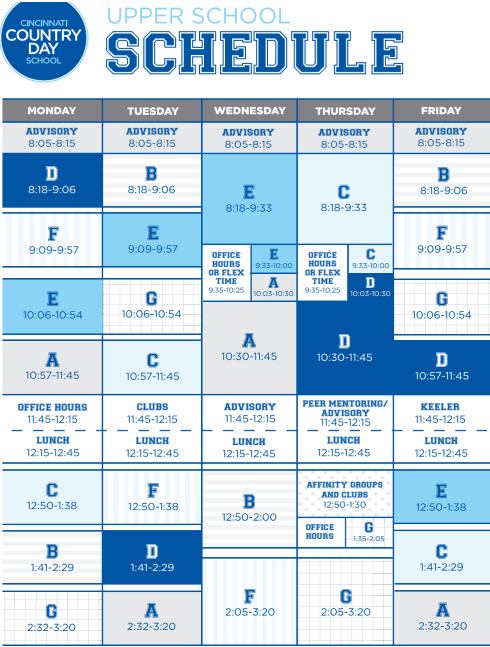As the Upper School adjusts to the new schedule and struggles with its new way of organizing our days, we wonder what makes this schedule better or worse than its predecessor. In fact, what makes a good schedule at all?
Time is a construct and the way we divide it is mostly abstract, apart from the circadian rhythm of sleep, how we spend our 12 waking hours is largely up to us (our employers, teachers and parents). Before the 1900s people worked a variety of schedules but in the records of the industrial revolution the most common schedule was a 70 hour work week consisting of six 12 hour days. In 1926 Henry Ford introduced the 5-day, 8 hour work week to increase worker productivity an idea originally presented in Tom Mans 1887 pamphlet on workers rights. The limitations on weekly hours were then institutionalized in FDRs 1938 fair Labor standards act which required that workers be paid overtime for any work done beyond 40 hours a week.
The creation of the work schedule thus created the school schedule which was standardized in the 1900s to include summer break and it began in the early morning as school was meant to look after the children of day laborers. The conventions decided on in the early 20th century have largely remained over the years with only 10% of the United States deviating in days per week or year round scheduling. Within the 6-8 hour school day however there have been various methods of class scheduling. The more traditional version of having students meet with each class every day for many schools has gradually transitioned into block scheduling in an attempt to increase student performance. An attempt met with varying and inconsistent results. The block schedule is meant to increase the productivity of students by provisioning increased time for interactive lessons and group work rather than lecture. In theory the block schedule or some variation of it appears to be ideal however the lack of empirical research on the topic leaves no clear winner between traditional and block scheduling.
Without a clear choice between the two and with the aggravating reality that we are only really in control of our schedule in the hours outside of school there is still the question of what makes a good personal schedule, either on weekends or within the time we have outside of other obligations. Although this amount of time may seem small the various method of dividing and planning it are far more expansive. First of all, how do we quantify a good schedule? Yes productivity is the main concern but so is sustainability and enjoyment. A productive schedule that will burn you out in two weeks is no longer a good schedule. So i have broken the various ways to find an ideal schedule into 3 methods of inquiry. Psychological Research, Famous geniuses and Personal reflection.
Psychological Research focuses on the methods of dividing time created by scientists and researchers over the years. There are hundreds of these methods but three examples that you may know are: Pomodoro, time blocking and “eat the frog”. The pomodoro method was created by entrepreneur Fransisco Cirillio in the 1980s. The method breaks up time and tasks into 25 minute blocks with a 5 minute break in between each working block and a 10 minute break after 3 working blocks. The main point of the schedule is to separate work from completing a task entirely and to create a sustainable working pace that does not lead to burnout. The time blocking method is similar to the pomodoro method as it breaks up time into pieces and includes short breaks in between, however it focuses on how much time a task takes and building a schedule around blocks of time corresponding to a specific task. Within these methods there are also strategies such as “eat the frog” which focus on increased productivity by changing the order of tasks, in this case doing the most difficult task first.
The famous genius method is much less empirical instead focusing on the most well known and intelligent people of the past to try and find some pattern or key to productivity. The three most well regarded schedules in this category are those of Benjamin Franklin, Winston Churchill and Leonardo DiVinci. An artical In the harvard business review discusses schedules of geniuses including these and takes small insights such as Franklin’s purposeful way of deciding what he will do each day, Churchills relaxing morning routine and DaVinci’s early start to the day. Each of these schedules are meant to maximize the productivity and creativity of the individual therefore the practices that they repeat each day can be helpful in informing us on how to improve the ways in which we spend our time.
1. Benjamin Franklin (Founding Father, Inventor)
- 5:00 AM: Wakes up and spends the first hour reflecting on the question, “What good shall I do this day?” followed by planning his day.
- 6:00 AM – 8:00 AM: Work and study, usually reading or writing.
- 8:00 AM – 12:00 PM: Focuses on his main professional tasks (printing business, scientific research, etc.).
- 12:00 PM – 2:00 PM: Lunch and leisure time, often socializing or reading.
- 2:00 PM – 6:00 PM: Continues with work, professional or community-related projects.
- 6:00 PM – 10:00 PM: Dinner, followed by review of the day, asking himself, “What good have I done today?”
- 10:00 PM: Bedtime.
2. Winston Churchill (Prime Minister of the United Kingdom during WWII)
- 7:30 AM: Wakes up and spends the first hour in bed reading newspapers and dictating to secretaries.
- 9:00 AM: Takes a bath, followed by a substantial breakfast with more reading.
- 11:00 AM – 1:00 PM: Morning work session, reviewing war reports, writing memos, and preparing speeches.
- 1:00 PM: Lunch, usually long and filled with conversation, often involving guests.
- 3:00 PM – 5:00 PM: Short nap (he considered this essential for maintaining his stamina), followed by another bath.
- 5:00 PM – 8:00 PM: More work, meetings, and preparation.
- 8:00 PM: Dinner, often a social occasion with family and friends.
- Late evening: Churchill would continue working or dictating until 2:00 or 3:00 AM before going to bed.
3. Leonardo da Vinci (Renaissance Artist and Inventor)
- 4:00 AM: Wakes up early to start sketching, working on paintings, or making notes for inventions.
- 6:00 AM – 10:00 AM: Intense work period, where he would focus on multiple projects—painting, anatomy, engineering designs.
- 10:00 AM – 12:00 PM: Takes a break for food and short rest, but often continues sketching or jotting down ideas.
- 12:00 PM – 4:00 PM: More work, sometimes traveling to different locations for studies or engaging with patrons.
- 4:00 PM – 6:00 PM: Spends time observing nature, studying plants, animals, and human forms for inspiration.
- 6:00 PM: Eats dinner, often light and quick, followed by reflection and planning the next day’s work.
- Late evening: Would work in bursts until late into the night, often taking short naps throughout the day instead of a full night’s sleep.
Personal reflection is a method that uses various systems of tracking productivity to determine when and why you are productive in an attempt to schedule around your natural cycle of energy throughout the day. One way this is done is through time auditing which is the process of recording what activities you do and how long you spend doing them in a week. The data from this can then be used to determine where you could better use your time and what you want to prioritize spending time on.
Overall although the schedule of our school is not empirically bad even if we believe it is unideal we cannot easily change it as students so with the time in which we decide our actions it is important to create a personal schedule which is ideal.






